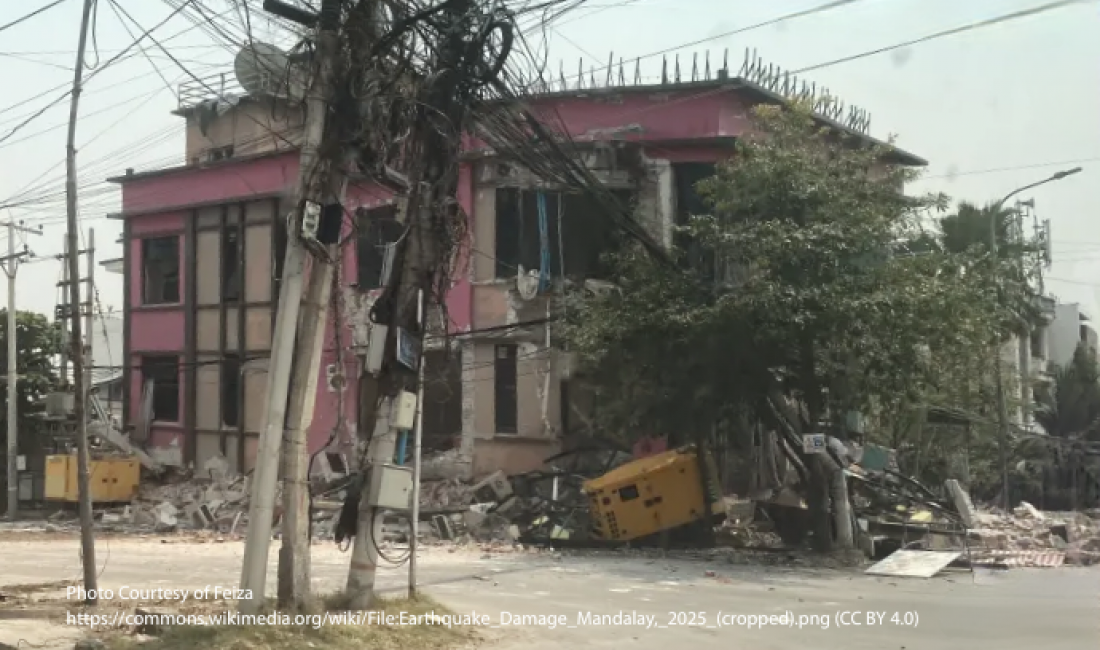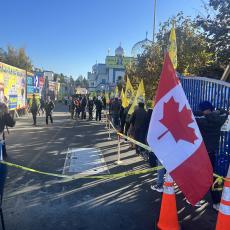Myanmar's Earthquake Magnifies the Neglect of Local Communities
Aung Myint* still recalls the horror that unfolded on March 28 while he was having lunch with his wife.
“Everything started collapsing around us, and when we managed to crawl out, some neighbors and loved ones were dead.”
The massive earthquake that struck central Myanmar has left a trail of challenges that continue to be felt across the disaster-hit parts of the Southeast Asian country. Frequent strong aftershocks and torrential rains have rendered whatever remains of their homes uninhabitable, forcing them to move into temporary shelters.
“Most of us are scared of sleeping indoors … We prefer braving the heat and rain outdoors to being inside a building, always scared [the roofs] may fall on our heads,” he says.
As of April 18 the resulting death toll had reached 3,700, with 4,800 injured and 129 missing. The regions worst affected by the earthquake – East Bago, Magway in central Myanmar, north-central Mandalay, north-west Sagaing, and southern Shan State – have suffered widespread devastation. Home to over 17 million people, these areas witnessed massive damage to croplands, irrigation networks, and medical facilities. Over 41,000 houses were destroyed.
“The real toll is likely much higher, with challenges in data collection, verification and processing and underreporting making it difficult to grasp the full scale of the disaster,” the United Nations Office for the Coordination of Humanitarian Affairs (OCHA) noted in its latest situation report.
For a country that has been under the military junta and living through a civil war in the past four years, the tremor serves only to exacerbate its people’s collective woes. Armed conflict between the military and ethnic armed groups has been escalating over the past few years. The junta has tried to violently crush anti-coup protests by various ethnic groups, which, according to the NLD, control 144 out of the country’s 330 townships as of early this year.
Civilian casualties from the war alone have exceeded 6,000, while people continue to suffer an unrelenting hunger crisis and crimes against humanity perpetrated by the Myanmar military. It’s been “disaster upon disaster,” said the U.N. special rapporteur on human rights for Myanmar, Tom Andrews.
Basic supply shortfalls
The myriad challenges now confronting Myanmar began in February 2021 when the State Administration Council, or the junta, seized power from the civilian government under the then-ruling National League for Democracy (NLD).
Before the March 2025 earthquake, access to healthcare in Myanmar was already severely hampered by supply chain disruptions, shortages of essential medicines and healthcare workers, and high inflation. Today, “food, water, and even medicines are scarce. We have no place to go as the roads are blocked,” rues Aung Myint. Torrential rains and continued aftershocks in the weeks since the earthquake have intensified public health concerns.
In Sagaing, the quake’s epicentre, 80 percent of buildings were destroyed, and entire sections of one of the main bridges over the Irrawaddy River snapped off. Road fissures so deep they could swallow cars were filled with stagnant rainwater.
Many people, like Myint, who were left homeless by the earthquake, have been forced to move into temporary rescue shelters, which are ill-equipped to withstand the elements. But as “the ground shook again and again,” they decided “it was safer to camp in car parks or by the roadside,” he says.
Banya Khung Aung, founder of the Karenni Human Rights Group, which assists other civil society organizations in central Myanmar with their relief efforts, expressed deep concern over the potential spread of waterborne diseases amid the unsanitary conditions of the areas worst hit by the earthquake.
The World Health Organization has warned against a series of rapidly rising health threats for tens of thousands of displaced people in earthquake-affected areas: tuberculosis, HIV, vector-borne, and water-borne diseases.
“We fear that in a month or so, water-borne diseases could become a big public health problem,” Aung says. “But sadly, there is a huge shortage of everything, including medical supplies.”
Where are the doctors?
The U.N. estimates that as many as 86 percent of Myanmar’s healthcare facilities in the affected areas were damaged by the earthquake, and that more than nine million people – including 2.7 million children – have been worst affected. The structures that remained standing were quickly overwhelmed by the number of injured being brought in, according to WHO.
An Asia-based non-profit, which wishes to remain anonymous, undertaking post-earthquake relief and rehabilitation operations in Mandalay, Sagaing, and other affected areas, says health access and earthquake relief have been further hampered by a shortage of medics.
“Doctors were at the forefront of the civil war against the military junta government, and they basically moved into the private sector and refused to work for the military government. In response, the government effectively shut down most private hospitals,” says their spokesperson.
Compounding this situation are restrictions imposed on movement, hampering relief operations and rendering many affected areas hard to reach, according to humanitarian agencies like Médecins Sans Frontières.
In eastern Karenni state, where the earthquake caused water in several streams to recede and turn brown, Aung says the junta restricted movement on roads, making it “hard for us to receive supplies.” Many people were forced to drink water from the murky streams.
By mid-April, the U.N. Refugee Agency managed to airlift over 40,000 kilograms of life-saving aid for nearly 16,000 people to Yangon, Myanmar’s largest city and the country’s commercial center. This was followed by WHO’s mobilization of almost 140 tonnes of medicines, medical devices, and supplies to meet the basic health needs of around 450,000 people for three months. It has also deployed 16 emergency medical teams in Myanmar.
However, the deployment of international aid in Myanmar has been confronted by another severe challenge – funding cuts imposed by the United States government under President Donald Trump.
In the past, the U.S. responded robustly to offshore disasters. For example, it contributed $185 million towards rescue and recovery efforts in Turkey and Syria, which were struck by a 7.8-magnitude earthquake in 2023.
Two years later, images of the U.S.’s global humanitarian response have contrasted sharply with those of the recent past. Just recently, the three-member assessment team deployed by the U.S. Agency for International Development (USAID) to Myanmar after the earthquake was served dismissal notices only hours after they landed in the Southeast Asian country. This unfortunate development was part of the U.S. government’s downsizing of USAID’s international staff.
International agencies that used to receive a significant amount of funding from USAID have since been forced to scale back their activities and launch frantic calls for donations. For example, WHO has appealed for $8 million to deliver critical health assistance in Myanmar, while the Food and Agriculture Organization under the United Nations is seeking $8.3 million to assist with agricultural inputs, financial assistance, and the rehabilitation of damaged rural infrastructure. The World Food Program says it needs $40 million for emergency response for Myanmar.
Weaponizing humanitarian aid
In the immediate aftermath of the earthquake, the junta and ethnic resistance groups called for a ceasefire. Yet, according to the country’s government-in-exile, National Unity Government (NUG), the military junta carried out 92 airstrikes and artillery attacks, resulting in the deaths of 72 civilians, as of April 9.
According to the U.N. Human Rights Office spokesperson Ravina Shamdasani, since the earthquake, there had been over 120 attacks – “more than half of them after their declared ceasefire was due to have gone into effect on 2 April.”
“At a moment when the sole focus should be on ensuring humanitarian aid gets to disaster zones, the military is instead launching attacks,” she said.
Aung of the Karenni Human Rights Group says that while the junta permitted most aid operations in severely affected areas, including Naypyitaw, its seat of power, it denied aid to many resistance-controlled territories, including those held by the People’s Defense Force under the NUG.
In an open letter dated March 31, 265 regional and international civil society organizations urged the international community to send emergency relief directly to the affected communities in Myanmar through local community groups and in collaboration with the NUG, ethnic resistance organizations, or civil society.
“We emphasize that these disaster relief efforts, through any implementing partners, must not be exploited, manipulated, or weaponized by the military junta for its political and military gain,” they said.
Blockade of life-saving aid to affected communities echoes a time in Myanmar, in 2008, when it was hit by Cyclone Nargis, a deadly tropical cyclone. The junta similarly weaponized disaster relief, obstructed international aid, and withheld it from desperate survivors to coerce votes in their favor during the referendum on a new constitution. Local volunteers were arrested for attempting to deliver assistance.
The groups recalled this dark chapter in the nation’s history in their letter.
Aung, one of the letter’s signatories, says this is history repeating itself. “We know that foreign aid is coming,” he says. “But we can’t see where it is going … I want to ask, where are the relief camps?”
He asks why the State Administration Council, or the junta, is “silent while our people are camping by the roadside in the rain?”
Meanwhile, earthquake survivors like Aung Myint are struggling to rebuild their lives. But they know that deep fissures in the country’s socio-political fabric, which echo the ones left behind by the earthquake, will be even harder to repair.



